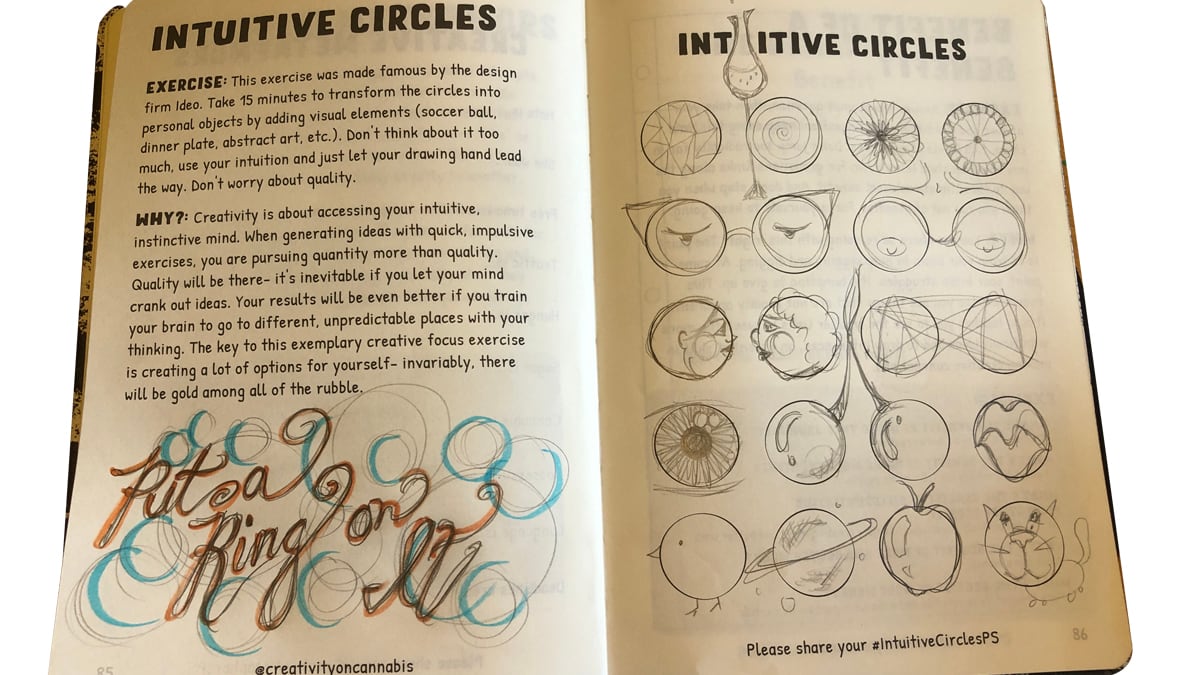The Pilgrim Soul Creative Thinking Journal's first prompt is for its users to just go get high.
The cover of the book literally reads, "Please Use This Journal While You Are High" in a font larger and bolder than any other text. While this would make any stoned teenager squee with excitement, my current weed-mom exterior wondered how a structured journal meant to stoke creativity could possibly compare to my own self-prompted stoned sketchbook buffoonery. But if you don't have a lifetime of creative journals already taking up valuable bookcase space, the Pilgrim Soul Creative Thinking Journal might actually change your life.
Obviously, it is not a traditional journal. It's more like an activity book filled with creative prompts meant to activate latent imagination. Cannabis is a theme throughout, but even teetotalers could find themselves inspired by some of the suggestions.
WW spent a week getting high and working through some of the journal's least constrictive prompts. The results were a mixed bag, but for bored stoners who've exhausted the creative fulfillment of adult coloring books and are looking for a different outlet, this feels like it was made especially for y'all.
How to Use It:
Right off the bat, a William Butler Yeats poem introduces the phrase Pilgrim Soul before 15 more pages outline the generalities of the creative process. A graphic interpretation of right brain function versus left brain function, a satellite chart of pop culture's most famous cannabis users from Shakespeare to Obama, and a few mindset-process explainers all precede any actual prompting.
The journal is broken up into four sections: Creative Imagination, Creative Focus, Creative Awareness and Creative Reflection, each section containing 15 to 20 exercises. A particularly ambitious person could probably complete the entire book over the course of a day, stoned or nah.
Part I: Creative Imagination
In this section, prompts are themed around invention: a Three Lies and a Truth-style writing exercise, an activity drafting meanings for absurdist road signs, and a few simple abstract drawing and slogan-structuring prompts all stood out as fun time wasters reminiscent of Mad Libs or even exquisite corpses if done with a pal. My favorite pages were squiggle birds, a meditative exercise wherein users attach beaks, eyes and feet to random doodles to create birdlike creatures, and the Three Lies and a Truth game where I felt challenged to match my most outrageous truths to equally audacious lies. (Do I have slutty gay dads, gay insta-stoner grandmas, closeted gay trucker grandpas or gay ghost moms? Who knows?)
On a strangely sour note, the final exercise in this chapter asks users to recall the last 10 solicitations they received and imagine what might occur if they said "Yes to Everything." All 10 of mine were either heartrending asks from my houseless neighbors or delivered in the form of sloppy, invasive catcalls. For women and femmes, this exercise was a tad tone deaf.
Part II: Creative Focus
Deep thinking and creative problem solving are at the root of the activities contained in this chapter, and the prompts are vague enough to be as complex or as lighthearted as the user desires. Exercises like Creative Metaphors and Abstract Analogies ask the user to answer questions like "How is being in a relationship like cleaning the bathroom?" or to complete phrases like "Love is…" or "Possessions are…" There is as much room in these exercises for deep philosophizing as there is for lowbrow high jinks.
The introduction to semiotics (the relationship between words and symbols), a formidable game of word linking, and an exercise prompting users to plunge down the rabbit hole of a chain of benefits were additional chapter standouts. This section is particularly writing-heavy, and could offer additional value to novice writers looking to strengthen their linguistic chops in addition to wheeze-laughing with buddies over each other's contributions.
Part III: Creative Awareness
The third section of the journal urges users to establish mindful awareness of details, with prompts that cue users to, for example, describe the bejesus out of imaginary talk-show guests, hypothetical stacks of junk mail, and the assumed penmanship of a handful of personality archetypes. This chapter felt extraneous for me: It was difficult to drum up the enthusiasm necessary to reimagine a college admissions process or a more creative way to take a nap. An exercise wherein users come up with a dozen weird cat names lightens the mood, but not enough to make this chapter super-appealing to a person who wants to get high and doodle.
Also, it occurs to me that many of the creative tasks in this chapter feel geared more toward career marketers searching for some new brand-messaging perspective than bored stoners looking to occupy themselves for a few afternoons. An exercise prompting users to employ technical writing skills to write guides for esoteric concepts and an activity that requires imagining snarky comments for wholesome hypothetical Instagram accounts feel like an inconspicuous lesson in social media marketing for olds.
Part IV: Creative Reflection
The final chapter asks users to invest in some self-discovery and potentially navigate some trauma in order to access their empathy. These prompts are more diarylike than anything in the other chapters, which all felt like alternative ways to pass time that might otherwise be spent in front of a screen. In the Reflection chapter, however, users are asked to write letters to past selves, isolate their negative internal monologues, and construct their own eulogies. Where the previous chapters all seemed full of giggly, sharable content, this chapter alone felt like it had the potential to be revelatory in regards to my own creative processes.
In the Reflection section, users are prompted to reflect on their most influential fictional characters, unpack the motivations of their negative self-talk, and finally pour their heart into a Proust Questionnaire, the famously revealing self-interview made popular by Vanity Fair magazine.
The remaining pages are dedicated to visual riddles like rabbit versus duck, false depth perception, and how many black dots do you see? An appropriately benign palate cleanser considering the aggressive self-discovery the previous chapter required.
The Bottom Line:
This journal feels like a primer for people who may be intimidated by their own creativity, or perhaps haven't found a safe place to explore the possibilities of their own imagination. Or maybe middle-aged marketing execs looking to diversify their antiquated persuasion tool kits. Either way, Pilgrim Soul Creative Thinking Journal's structure offers specific tools that extend beyond the page, and can result in a future bright with blank Moleskines, ready to accept all manner of creative thinking.
BUY IT: The Pilgrim Soul Creative Thinking Journal is available at pilgrimsoul.com. $29.95.

